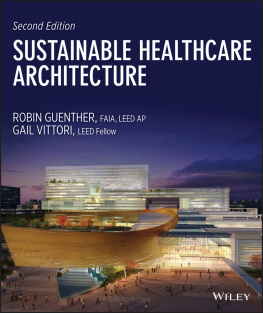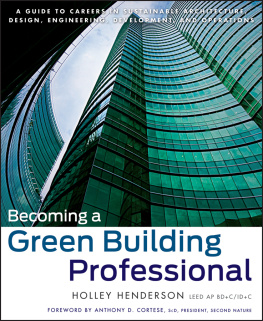
Sustainable Healthcare Architecture

Second Edition
Robin Guenther, FAIA, LEED AP
Gail Vittori, LEED Fellow

Cover image: HMC Architects
Cover design: Michael Rutkowski
This book is printed on acid-free paper. 
Copyright 2013 by John Wiley & Sons, Inc. All rights reserved
Published by John Wiley & Sons, Inc., Hoboken, New Jersey
Published simultaneously in Canada
No part of this publication may be reproduced, stored in a retrieval system, or transmitted in any form or by any means, electronic, mechanical, photocopying, recording, scanning, or otherwise, except as permitted under Section 107 or 108 of the 1976 United States Copyright Act, without either the prior written permission of the Publisher, or authorization through payment of the appropriate per-copy fee to the Copyright Clearance Center, 222 Rosewood Drive, Danvers, MA 01923, (978) 750-8400, fax (978) 646-8600, or on the web at www.copyright.com. Requests to the Publisher for permission should be addressed to the Permissions Department, John Wiley & Sons, Inc., 111 River Street, Hoboken, NJ 07030, (201) 748-6011, fax (201) 748-6008, or online at www.wiley.com/go/permissions.
Limit of Liability/Disclaimer of Warranty: While the publisher and author have used their best efforts in preparing this book, they make no representations or warranties with the respect to the accuracy or completeness of the contents of this book and specifically disclaim any implied warranties of merchantability or fitness for a particular purpose. No warranty may be created or extended by sales representatives or written sales materials. The advice and strategies contained herein may not be suitable for your situation. You should consult with a professional where appropriate. Neither the publisher nor the author shall be liable for damages arising herefrom.
For general information about our other products and services, please contact our Customer Care Department within the United States at (800) 762-2974, outside the United States at (317) 572-3993 or fax (317) 572-4002.
Wiley publishes in a variety of print and electronic formats and by print-on-demand. Some material included with standard print versions of this book may not be included in e-books or in print-on-demand. If this book refers to media such as a CD or DVD that is not included in the version you purchased, you may download this material at http://booksupport.wiley.com. For more information about Wiley products, visit www.wiley.com.
Library of Congress Cataloging-in-Publication Data:
Guenther, Robin.
Sustainable healthcare architecture / Robin Guenther, Gail Vittori.Second edition.
pages cm
Includes bibliographical references and index.
ISBN 978-1-118-08682-7 (hardback : alk. paper); 978-1-118-41611-2 (ebk.); 978-1-118-41865-9 (ebk.); 1.
Hospital architectureEnvironmental aspects. 2. Health facilitiesDesign and constructionEnvironmental aspects. 3. Sustainable architecture. I. Vittori, Gail. II. Title.
RA967.G827 2013
725.51dc23
2013004583
Our lives are touched by those who lived centuries ago, and we hope that our lives will mean something to those who will live centuries from now. It's a great chain of being, someone once told me, and I think our job is to hope, to dream and to do the best we can to hold up our small segment of that chain.
Dorothy Day
For Perry Gunther and Pliny Fisk III
FOREWORD
THE GREEN BUILDING MOVEMENT is guided by a simple, yet revolutionary, idea: that the buildings in which we live our lives can nurture instead of harm, can restore instead of consume, and can inspire instead of constrain. The business case for green building is highly compelling, and it is a large part of the reason that we have made such great strides in the last fifteen years. But it is important for us to remember that at its core, green building is about making the world a better place for people to live. In the second edition of Sustainable Healthcare Architecture, Robin Guenther and Gail Vittori present their essential guide to sustainable design and environmental stewardship for the healthcare industry. The second edition builds upon the groundbreaking first volume, detailing how resilient and regenerative design is transforming the sterile, imposing facilities of the pastreplacing them with buildings that are filled with daylight, connected to nature, and, above all, designed to promote health and well-being and combat climate change.
The way we design, construct, and operate buildings has a profound impact on our health and the health of our environment. For too many years, the impact has been negative, from carbon dioxide emissions and construction waste to the wanton use of energy, water, and natural resources. Often, indoor air is more polluted than the air outside and has been linked to illnesses ranging from asthma to cancer.
That's the bad news. But the positive corollary is that changing the way we build offers unprecedented opportunities to have a positive impact on human and environmental health. Green buildings consume fewer resources, generate less waste, and dramatically curb emissions. The people who live, work, learn, and heal in green buildings are healthier, happier, and more productive. And the communities we build with green homes, offices, schools, and hospitals are the foundation of a healthy, prosperous future for generations to come.
The convergence of these opportunities in the healthcare sector has brought us to a watershed moment for both the green building movement and the healthcare industry. Healthcare has a huge influence on our nation's economy and politics, and in no other sector are the human health impacts of buildings more explicit or more important. With the healthcare industry's leadership, we can dramatically advance green building throughout the marketplace, while increasing our focus on critical public and human health issues.
Meeting patient needs is a hospital's top priority. Through what some experts are now terming healing architecture,
Compared to other building types, healthcare facilities have an especially large impact on the environment. Operating those buildings to meet patient needs consumes tremendous energy and resources; hospitals use twice as much energy per square foot as office buildings and spend nearly $3 billion each year on electricity alone.
Protecting the environment is a natural and necessary extension of this missionas this book makes clear, you can't have healthy people on a sick planet. In the last decade, healthcare has made remarkable changes in its operations, such as creating safer, no-burn waste management practices and eliminating the use of mercury-based products. But the fact is that the healthcare sector can and mustdo more. Climate change is a ticking clock, a threat to the very systems on which we depend for life. Transforming the design, construction, and operations of our buildings is our best chance to stop time.
The U.S. Green Building Council (USGBC) was founded in 1993 with a mission that was at once wildly ambitious and terribly urgent: to transform the building industry to sustainable practices. The origins of this mission can be traced to the energy crisis of the early 1970s, which prompted the architectural community to focus on energy efficiency in buildings. But recognizing that sustainability is about more than energy, architect Bob Berkebile asked a question that would fundamentally change the way we think about our built environment: Are our designs improving quality of life, health, and well-being, and the quality of the neighborhood, community, and planet?
Next page














